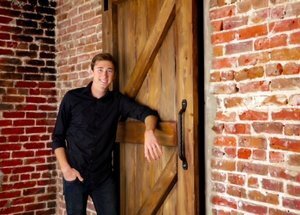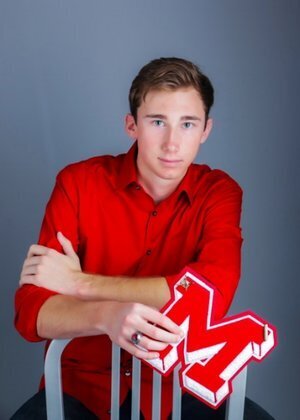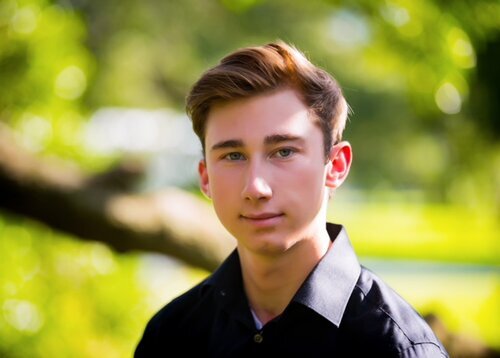Caleb T’s Story - Congenital Diaphragmatic Hernia (CDH)
After battling with infertility for more than six years, with the help of medical interventions, we finally learned that we were pregnant. We were elated to learn that we were expecting twins! Every doctor visit showed two healthy appearing babies on ultrasound until about 30 weeks gestation. That was the day my world shattered.
At 29 weeks, I was placed on bed rest with signs of preterm labor. A close eye was kept on my twins through monitoring and frequent ultrasounds. The following week I was back in my OBGYN’s office. As usual he performed an ultrasound, but this time he hesitated, stopped, and studied the image on the screen. He explained that he saw twin b’s (my son) stomach up near his heart. He didn’t alarm me too much but said I needed to go to Shands at UF for a closer look. He mentioned that my baby boy might have a “diaphragmatic hernia.” That was the first mention of this life-threatening birth defect. I didn’t know it was life-threatening at this point, but I realized it must be serious because my doctor’s office made my Shands visit for the very next day.
At that time, we lived in Keystone Heights, FL, a small town outside of Gainesville, FL near to where Shands Teaching Hospital was located. At our appointment at Shands, the high-risk OB was extremely thorough on the ultrasound examination. After it was complete, he took us in a room and drew a sketch on his notepad saying, “This is what a normal baby has in his chest, and this is what your son has in his chest.” From what he could see, our precious baby had his stomach, kidney, spleen, and intestines in his chest cavity. Our baby had a left sided hernia so his left lung did not have room to develop. The doctor described it as a “lung bud.” The gravity of the diagnosis was beginning to sink in.
We went home with more questions than we had going to that appointment. In a short amount of time, we learned what we could about this life-threatening birth defect. We also learned that Pediatric Surgeon Dr. David Kays had one of the highest survival rates in the world for a congenital diaphragmatic hernia repair. We felt extremely blessed to live near the best pediatric surgeon for our baby’s particular problem. After meeting Dr. Kays in person, we knew God had us at the right place for our son’s repair. He didn’t sugar coat the prognosis but still offered much hope with his past success stories.
The next eight weeks seemed like an eternity. Darin and I had to work through many mental, emotional and spiritual challenges, questioning why our baby would have to fight for his life. We did feel the prayers and encouragement of others which enabled us to keep our faith strong for Caleb’s complete healing. We thought we were ready. We believed for healing, but we had no idea how far our faith would be tested.
On October 18, 2000, the time finally came to deliver the twins. With a room full, Cara Marie was born first. She was a beautiful, healthy baby girl. We had such conflicting emotions. Five long hours later, Caleb Michael was born. With barely a glance, Dr. Kays and the practitioners present took him away to be assessed and ventilated. His faint, weak cry as he entered the world still lingers in my mind.
Caleb did well initially but started to have problems within the first 24 hours. Dr. Kays couldn’t wait even a full day to perform the repair surgery. He placed the stomach, kidney, spleen, and intestines back in the abdomen and patched the diaphragm. Caleb required extracorporeal membrane oxygenation (ECMO). What Dr. Kays thought was a moderate case of CDH was now thought to be severe. Hopes were that the left lung would develop now that it had room to grow.
While on ECMO, Caleb had many near-death episodes. Three days after Caleb was born, Dr. Kays came to us with more bad news. A bleed in his brain was detected through a head ultrasound which is routinely performed on babies who are on ECMO. We knew this was a possible side effect of ECMO. He had to ask us if we wanted to turn off the life support. We were not ready to give up, and neither was Dr. Kays. I can remember the doctor sitting beside our sick baby, staring, thinking, and adjusting his care. I knew our baby was in the best earthly hands. Now we needed believers to pray for a miracle.
Three days after the brain bleed was detected, we finally received the first good news about Caleb. The bleed was no longer visible on ultrasound. We were cautioned that even though the bleed could not be seen, it would have still caused some degree of brain damage. Now Dr. Kays wanted to do an exploratory surgery to see why Caleb’s cardiac output and perfusion were doing so poorly. During this surgery, the doctor converted ECMO to venoarterial. Now the machine was connected directly to one of Caleb’s carotid arteries.
Caleb started to slightly improve. The entire time while on ECMO (21 days) it was a rocky course. He needed a right and left chest tube to drain excess fluid from his chest. He was finally able to come off of ECMO and was weaned off of the ventilator a week later. Caleb was now almost a month old. His perfusion difficulties would eventually cause him to lose portions of all ten toes. When we seemed shocked to find out that we would have to let his toes fall off one by one, Dr. Kays suggested we put a toe under his pillow and see if the “toe fairy” would come. We had to laugh or we’d be crying!
The remainder of his recovery was remarkably fast. Most CDH babies have feeding issues and reflux problems, but Caleb had neither. He took his feedings by mouth, and to everyone’s amazement, breastfed like a pro. Before discharge, a CT scan showed a normal looking brain. What a miracle! Besides some liver levels being high, his toes in the process of falling off, and him being on oxygen, we took our “perfect” son home on December 6, 2000, fifty days after his birth.
The past twenty years have truly been a blessing! Caleb flourished and excelled in school, sports, and music. Caleb’s funky feet (from the loss of his toes) never bothered him; in fact, he was always proud to show them off. Caleb did receive ESE services in elementary school and received occupational therapy to improve his fine motor skills. His I.E.P. was maintained throughout school so he could receive accommodations for an extended time. Caleb graduated high school in the top ten percent of his class and attended college at the University of North Florida on a 100% academic scholarship. Caleb is now a 20-year-old college student who will graduate with a Health Administration degree in December of 2021. He has never been hospitalized since birth. That is absolutely amazing, given his rough start! He still schedules follow-up appointments with Dr. Kays, but no further medical interventions have been necessary thus far. Caleb is excited to start life on his own and has far exceeded our hopes and dreams. His purpose-driven life will surely make a positive impact on our world. We thank God for Caleb’s complete healing and for leading us to Dr. David Kays!









